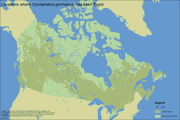Black stem borer

- Order: Coleoptera
- Family: Curculionidae
- Latin: Xylosandrus germanus (Blandford)
- English: Black stem borer
- French: Bostryche noir du Japon
Description
Distribution
British Columbia, Nova Scotia, Ontario, Quebec
Damage, symptoms and biology
The black stem borer can be detected in the early summer by the presence of small ''sticks'' of boring dust (frass) on the wood that resemble compressed sawdust worms. These result from the tunnels dug into the wood by the females to lay their eggs. However, the egg laying adults do not eat the wood, and the tunnels they dig are transversal with black walls. They run along the growth rings to a depth of 0.8 cm to 2 cm.
Ambrosia beetles attack various species of recently cut hardwoods (oak, walnut and beech) and peeled or unpeeled spruce. They can also be found on living trees. Not only do their activities clearly lower the quality and value of logs destined for market, but the insects can also be especially harmful by transporting a fungus called Fusarium that adult females may be carrying when they penetrate into the wood. Fusarium introduced into living trees causes cankers to form and at least a partial withering of the crowns. The mortality rate can be high for small-diameter trees. In addition to the presence of frass sticks on the surface of the wood in the spring, holes in one or several cankers may be a sign of the insects’ presence. In such cases, the affected parts must be removed and burned, if possible. One of the characteristics of ambrosia beetles is their apparent resistance to most traditional insecticides.
Comments
The black stem borer originates in eastern Asia and are found in Japan, Vietnam and China. They are also found in central Europe, where they were discovered in the 1980s (Switzerland, 1984). Xylosandrus germanus was first discovered in Canada near Point Pelee in Ontario around 1994. It was discovered by Canadian Forest Service in greater Vancouver in 1995. In western Canada it has been reared from both deciduous and coniferous hosts. The males are light brown in colour and smaller than the females (about 1.0 mm to 1.8 mm long), while the females are a shiny black colour and can grow to between 2.0 mm and 2.5 mm in length.
Ambrosia beetles colonize fallen wood and attack both peeled and unpeeled softwoods and hardwoods. They also damage living trees and in the United States, their tunnels have been detected in red maples, oaks, a variety of other hardwoods and various spruce species. In Canada, they attack black walnut (Juglans nigra L.), a highly valued species considered one of the noblest trees in our hardwood forests. Black walnut trees are found in eastern Canada, particularly in a few areas in Quebec.
After a blowdown or ice storm, the large number of damaged and weakened trees constitutes an open house for insects such as ambrosia beetles. Their activities exacerbate the damage caused by natural disturbances.
Information on host(s)
Main Host(s)
Conifer, deciduous
